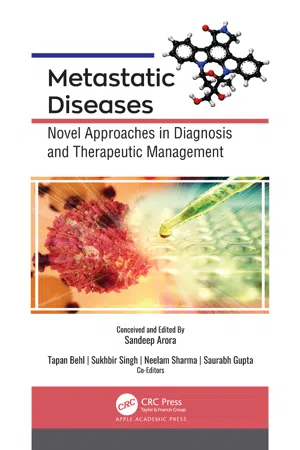
Metastatic Diseases
Novel Approaches in Diagnosis and Therapeutic Management
Sandeep Arora, Tapan Behl, Sukhbir Singh, Neelam Sharma, Saurabh Gupta, Sandeep Arora, Tapan Behl;, Sukhbir Singh, Neelam Sharma, Saurabh Gupta
- 298 pages
- English
- ePUB (adapté aux mobiles)
- Disponible sur iOS et Android
Metastatic Diseases
Novel Approaches in Diagnosis and Therapeutic Management
Sandeep Arora, Tapan Behl, Sukhbir Singh, Neelam Sharma, Saurabh Gupta, Sandeep Arora, Tapan Behl;, Sukhbir Singh, Neelam Sharma, Saurabh Gupta
À propos de ce livre
This insightful volume opens new horizons for exploring modern therapeutic entities and emerging targets for combating the deadly disease of cancer. The authors provide a review of cancer along with descriptions of its molecular level mechanisms and emphasize the role of promising new therapies, including herbal therapies, that can be utilized for the treatment of metastatic diseases. The chapters look at specific approaches that have been researched and developed and that have almost reached the standardization stage, such as intracellular mechanisms, particularly phosphoprotein-enriched astrocytes and transthyretin proteins; CXCR4; autophagy-inhibiting drugs; spatiotemporal genetic analysis; tyrosine kinase inhibitors; and more. Also considered are advances in diagnostic systems like intra vital microscopy and molecular imaging.
Foire aux questions
Informations
CHAPTER 1
A Review on Cancer: From Clinical Perspective to Chemotherapy
ABSTRACT
1.1 INTRODUCTION
1.2 ETIOPATHOGEIVESIS
1.2.1 STEPS INVOLVED IN CARCINOGENESIS
1.2.2 CARCINOGENS
| Drug or Hormone | Cancer Caused |
|---|---|
| Alkylating agents (e.g., chlorambucil, mechlorethamine, melphalan, and nitrosoureas) | Leukemia |
| Anabolic steroids | Liver |
| Analgesics containing phenacetin | Renal, Urinary bladder |
| Anthracyclines (e.g., doxorubicin) | Leukemia |
| Antiestrogens (tamoxifen) | Endometrium |
| Coal tars (topical) | Skin |
| Estrogens: | |
| Vagina/cervix, endometrium, breast |
| Endometrium, breast, liver |
| Lymphoma, skin |
Source: Compagni and Christofori (2000). | |
1.2.3 GENES ENTAILED IN CARCINOGENESIS
1.2.3.1 ONCOGENES
Table des matières
- Cover
- Half Title
- Title Page
- Copyright Page
- About the Editor
- About the Co-Editors
- Table of Contents
- Contributors
- Abbreviations
- Preface
- 1. A Review on Cancer: From Clinical Perspective to Chemotherapy
- 2. Phosphoprotein-Enriched Astrocytes as Potential Anticancer Agents
- 3. Autophagy-Modulating Drugs as Complements to Cancer Chemotherapy
- 4. Transthyretin Protein in Renowned Metastatic and Other Conditions
- 5. Role of CXCR4 Receptor Protein in Cancer Development and Therapies
- 6. C3D Complement System in Immunotherapy-Based Cancer Treatment
- 7. BH3 Mimetics
- 8. Spherical Nucleic Acid Platform-Based Drug Delivery for Brain Cancer and Improved Blood-Brain Barrier Crossing for Alzheimer’s and Other Diseases
- 9. Intra-Vital Microscopy: A New Amelioration in Cancer Immunotherapy Monitoring
- 10. Molecular Imaging: A New Advancement in Cancer Immunotherapy Monitoring
- 11. Spatiotemporal Genetic Analysis (SAGA) Technique for Cancer Cell Biology Studies
- 12. Plant-Derived Anti-Malarial Compounds and Their Derivatives as Anticancer Agents: Future Perspectives
- 13. Epigenetic Control of the Immune System and its Applications in Metastatic Diseases
- 14. Immune Checkpoint Inhibitors
- 15. Tyrosine Kinase Inhibitors in Lymphocytic Leukemia
- 16. Cyclooxygenase-1 (COX-1) Inhibitors in the Management of Neoplastic Disorders
- 17. Microfluidic Devices in Capturing Circulating Metastatic Cancer Cell Clusters
- Index